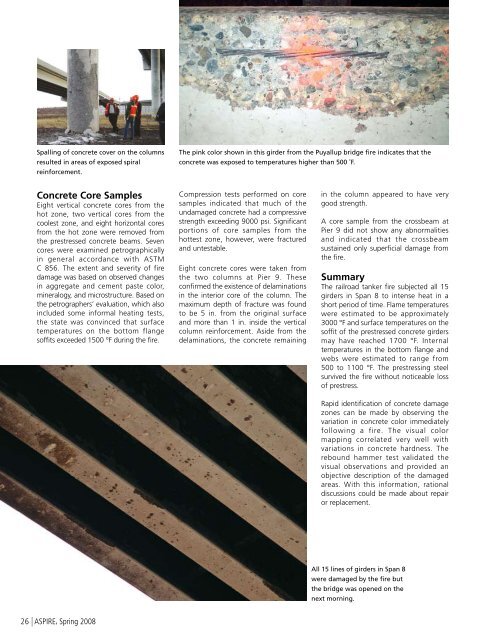ASPIRE Spring 08 - Aspire - The Concrete Bridge Magazine
ASPIRE Spring 08 - Aspire - The Concrete Bridge Magazine
ASPIRE Spring 08 - Aspire - The Concrete Bridge Magazine
Create successful ePaper yourself
Turn your PDF publications into a flip-book with our unique Google optimized e-Paper software.
Spalling of concrete cover on the columnsresulted in areas of exposed spiralreinforcement.<strong>The</strong> pink color shown in this girder from the Puyallup bridge fire indicates that theconcrete was exposed to temperatures higher than 500 ˚F.<strong>Concrete</strong> Core SamplesEight vertical concrete cores from thehot zone, two vertical cores from thecoolest zone, and eight horizontal coresfrom the hot zone were removed fromthe prestressed concrete beams. Sevencores were examined petrographicallyin general accordance with ASTMC 856. <strong>The</strong> extent and severity of firedamage was based on observed changesin aggregate and cement paste color,mineralogy, and microstructure. Based onthe petrographers’ evaluation, which alsoincluded some informal heating tests,the state was convinced that surfacetemperatures on the bottom flangesoffits exceeded 1500 °F during the fire.Compression tests performed on coresamples indicated that much of theundamaged concrete had a compressivestrength exceeding 9000 psi. Significantportions of core samples from thehottest zone, however, were fracturedand untestable.Eight concrete cores were taken fromthe two columns at Pier 9. <strong>The</strong>seconfirmed the existence of delaminationsin the interior core of the column. <strong>The</strong>maximum depth of fracture was foundto be 5 in. from the original surfaceand more than 1 in. inside the verticalcolumn reinforcement. Aside from thedelaminations, the concrete remainingin the column appeared to have verygood strength.A core sample from the crossbeam atPier 9 did not show any abnormalitiesand indicated that the crossbeamsustained only superficial damage fromthe fire.Summary<strong>The</strong> railroad tanker fire subjected all 15girders in Span 8 to intense heat in ashort period of time. Flame temperatureswere estimated to be approximately3000 °F and surface temperatures on thesoffit of the prestressed concrete girdersmay have reached 1700 °F. Internaltemperatures in the bottom flange andwebs were estimated to range from500 to 1100 °F. <strong>The</strong> prestressing steelsurvived the fire without noticeable lossof prestress.Rapid identification of concrete damagezones can be made by observing thevariation in concrete color immediatelyfollowing a fire. <strong>The</strong> visual colormapping correlated very well withvariations in concrete hardness. <strong>The</strong>rebound hammer test validated thevisual observations and provided anobjective description of the damagedareas. With this information, rationaldiscussions could be made about repairor replacement.All 15 lines of girders in Span 8were damaged by the fire butthe bridge was opened on thenext morning.26 | <strong>ASPIRE</strong>, <strong>Spring</strong> 20<strong>08</strong>
















